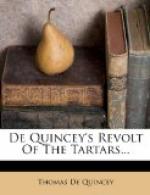The year of his departure from Oxford brought to De Quincey a long-coveted pleasure—acquaintance with two famous contemporaries whom he greatly admired, Coleridge and Wordsworth. Characteristic of De Quincey in many ways was his gift, anonymously made, of L300 to his hero, Coleridge. This was in 1807, when De Quincey was twenty-two, and was master of his inheritance. The acquaintance ripened into intimacy, and in 1809 the young man, himself gifted with talents which were to make him equally famous with these, took up his residence at Grasmere, in the Lake country, occupying for many years the cottage which Wordsworth had given up on his removal to ampler quarters at Rydal Mount. Here he spent much of his time in the society of the men who were then grouped in distinguished neighborhood; besides Wordsworth and Coleridge, the poet Southey was accessible, and a frequent visitor was John Wilson, later widely known as the “Christopher North” of Blackwood’s Magazine. Nor was De Quincey idle; his habits of study were confirmed; indeed, he was already a philosopher at twenty-four. These were years of hard reading and industrious thought, wherein he accumulated much of that metaphysical wisdom which was afterward to win admiring recognition.
In 1816 De Quincey married Margaret Simpson, a farmer’s daughter living near. There is a pretty scene painted by the author himself,[3] in which he gives us a glimpse of his domestic life at this time. Therein he pictures the cottage, standing in a valley, eighteen miles from any town; no spacious valley, but about two miles long by three-quarters of a mile in average width. The mountains are real mountains, between 3000 and 4000 feet high, and the cottage a real cottage, white, embowered with flowering shrubs, so chosen as to unfold a succession of flowers upon the walls, and clustering around the windows, through all the months of spring, summer, and autumn, beginning, in fact, with May roses and ending with jasmine. It is in the winter season, however, that De Quincey paints his picture, and so he describes a room, seventeen feet by twelve, and not more than seven and one-half feet high. This is the drawing-room, although it might more justly be termed the library, for it happens that books are the one form of property in which the owner is wealthy. Of these he has about 5000, collected gradually since his eighteenth year. The room is, therefore, populous with books. There is a good fire on the hearth. The furniture is plain and modest, befitting the unpretending cottage of a scholar. Near the fire stands a tea table; there are only two cups and saucers on the tray. It is an “eternal” teapot that the artist would like us to imagine, for he usually drinks tea from eight o’clock at night to four in the morning. There is, of course, a companion at the tea table, and very lovingly does the husband suggest the pleasant personality of his young wife. One other important feature is included in the scene; upon the table there rests also a decanter, in which sparkles the ruby-colored laudanum.




